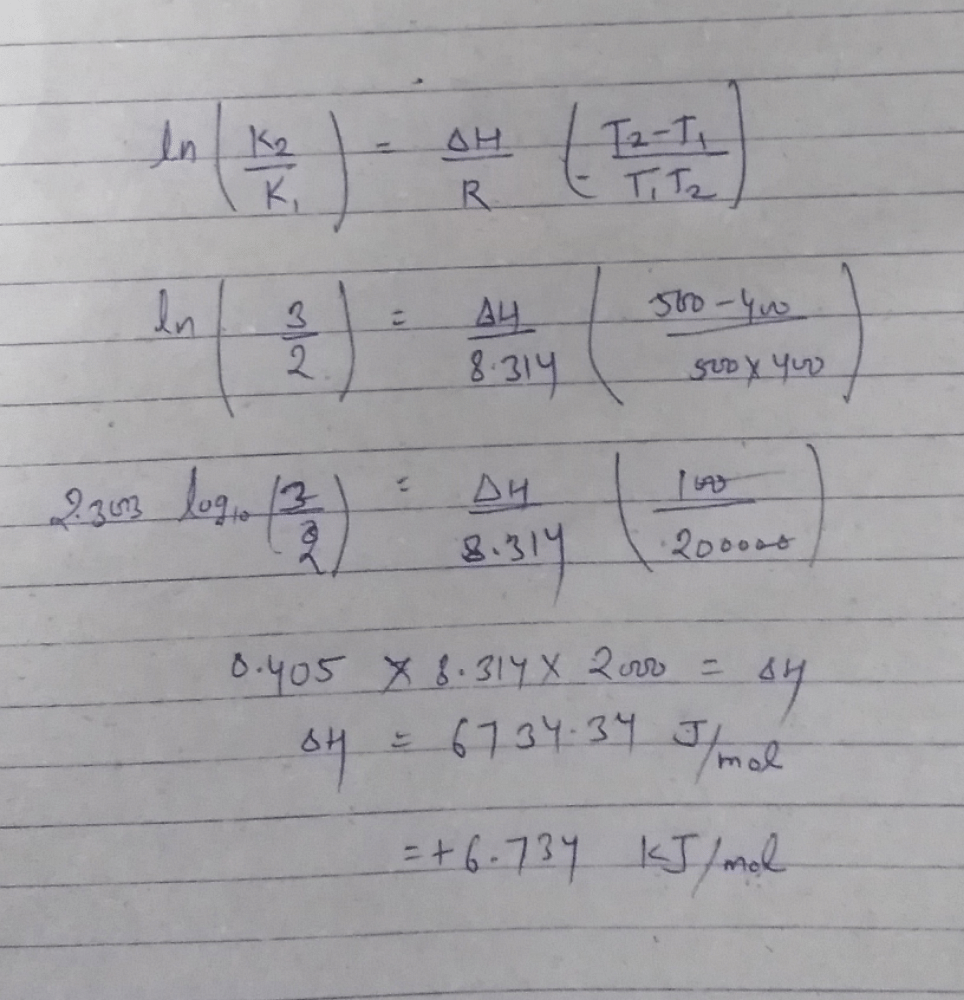IIT JAM Exam > IIT JAM Questions > The equilibrium constant of a gas phase react...
Start Learning for Free
The equilibrium constant of a gas phase reaction is 2.0 at 400k and 3.0 at 500k. the standard enthalpy (H) of this reaction is close to?
Most Upvoted Answer
The equilibrium constant of a gas phase reaction is 2.0 at 400k and 3....
Calculation of Standard Enthalpy Change for the Gas Phase Reaction
Introduction
The standard enthalpy change (ΔH°) for a chemical reaction is the amount of heat absorbed or released when one mole of the reactants in their standard states react to form one mole of the products in their standard states, at a specified temperature and pressure. It can be determined from the equilibrium constant (K) of the reaction at different temperatures using the Van't Hoff equation.
Van't Hoff Equation
The Van't Hoff equation relates the equilibrium constant (K) of a reaction at two different temperatures (T1 and T2) to the standard enthalpy change (ΔH°) and the standard entropy change (ΔS°) of the reaction.
ln(K2/K1) = -ΔH°/R [(1/T2) - (1/T1)]
where R is the gas constant (8.314 J/mol∙K).
Calculation
Given: K1 = 2.0 at T1 = 400 K and K2 = 3.0 at T2 = 500 K.
We can use the Van't Hoff equation to calculate ΔH° for the gas phase reaction.
ln(3.0/2.0) = -ΔH°/R [(1/500) - (1/400)]
Simplifying, we get:
ΔH° = -R ln(3.0/2.0) [(1/500) - (1/400)]
ΔH° = -8.314 J/mol∙K ln(1.5) [(1/500) - (1/400)]
ΔH° = -8.314 J/mol∙K x 0.04314
ΔH° = -359.6 J/mol
Therefore, the standard enthalpy change (ΔH°) for the gas phase reaction is approximately -360 J/mol.
Conclusion
The standard enthalpy change (ΔH°) for a gas phase reaction can be calculated from the equilibrium constant (K) of the reaction at different temperatures using the Van't Hoff equation. In this case, the calculated ΔH° was -360 J/mol.
Community Answer
The equilibrium constant of a gas phase reaction is 2.0 at 400k and 3....


|
Explore Courses for IIT JAM exam
|

|
Similar IIT JAM Doubts
The equilibrium constant of a gas phase reaction is 2.0 at 400k and 3.0 at 500k. the standard enthalpy (H) of this reaction is close to?
Question Description
The equilibrium constant of a gas phase reaction is 2.0 at 400k and 3.0 at 500k. the standard enthalpy (H) of this reaction is close to? for IIT JAM 2024 is part of IIT JAM preparation. The Question and answers have been prepared according to the IIT JAM exam syllabus. Information about The equilibrium constant of a gas phase reaction is 2.0 at 400k and 3.0 at 500k. the standard enthalpy (H) of this reaction is close to? covers all topics & solutions for IIT JAM 2024 Exam. Find important definitions, questions, meanings, examples, exercises and tests below for The equilibrium constant of a gas phase reaction is 2.0 at 400k and 3.0 at 500k. the standard enthalpy (H) of this reaction is close to?.
The equilibrium constant of a gas phase reaction is 2.0 at 400k and 3.0 at 500k. the standard enthalpy (H) of this reaction is close to? for IIT JAM 2024 is part of IIT JAM preparation. The Question and answers have been prepared according to the IIT JAM exam syllabus. Information about The equilibrium constant of a gas phase reaction is 2.0 at 400k and 3.0 at 500k. the standard enthalpy (H) of this reaction is close to? covers all topics & solutions for IIT JAM 2024 Exam. Find important definitions, questions, meanings, examples, exercises and tests below for The equilibrium constant of a gas phase reaction is 2.0 at 400k and 3.0 at 500k. the standard enthalpy (H) of this reaction is close to?.
Solutions for The equilibrium constant of a gas phase reaction is 2.0 at 400k and 3.0 at 500k. the standard enthalpy (H) of this reaction is close to? in English & in Hindi are available as part of our courses for IIT JAM.
Download more important topics, notes, lectures and mock test series for IIT JAM Exam by signing up for free.
Here you can find the meaning of The equilibrium constant of a gas phase reaction is 2.0 at 400k and 3.0 at 500k. the standard enthalpy (H) of this reaction is close to? defined & explained in the simplest way possible. Besides giving the explanation of
The equilibrium constant of a gas phase reaction is 2.0 at 400k and 3.0 at 500k. the standard enthalpy (H) of this reaction is close to?, a detailed solution for The equilibrium constant of a gas phase reaction is 2.0 at 400k and 3.0 at 500k. the standard enthalpy (H) of this reaction is close to? has been provided alongside types of The equilibrium constant of a gas phase reaction is 2.0 at 400k and 3.0 at 500k. the standard enthalpy (H) of this reaction is close to? theory, EduRev gives you an
ample number of questions to practice The equilibrium constant of a gas phase reaction is 2.0 at 400k and 3.0 at 500k. the standard enthalpy (H) of this reaction is close to? tests, examples and also practice IIT JAM tests.

|
Explore Courses for IIT JAM exam
|

|
Signup for Free!
Signup to see your scores go up within 7 days! Learn & Practice with 1000+ FREE Notes, Videos & Tests.



















